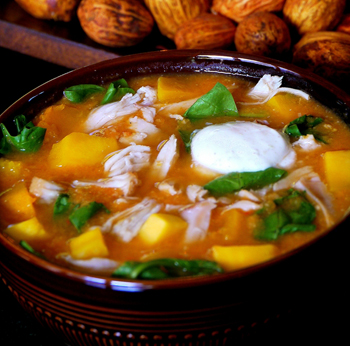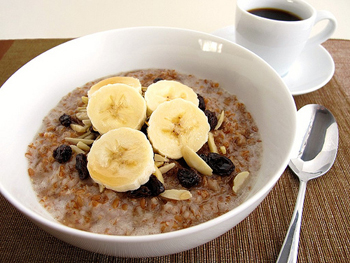 It's that time of year again when everyone is ready to jump onto the get-fit wagon. I could easily say that I should include myself in thatgroup, but I believe it's best to start by taking small steps before diving into a plan that you might not keep up. My first step for the New Year is a healthy one, it's simply to eat more healthy foods, like whole grains and to limit my intake of sugar. I actually love whole grains, but I just don't eat them often enough. Luckily my only downfall sugar-wise is chocolate, so it's easy for me to exclude sweets and candies entirely. But I've recently found myself using agave syrup as my choice of sweetener. That was my first step, what's yours?
It's that time of year again when everyone is ready to jump onto the get-fit wagon. I could easily say that I should include myself in thatgroup, but I believe it's best to start by taking small steps before diving into a plan that you might not keep up. My first step for the New Year is a healthy one, it's simply to eat more healthy foods, like whole grains and to limit my intake of sugar. I actually love whole grains, but I just don't eat them often enough. Luckily my only downfall sugar-wise is chocolate, so it's easy for me to exclude sweets and candies entirely. But I've recently found myself using agave syrup as my choice of sweetener. That was my first step, what's yours?
Eating whole grains doesn't just mean switching your morning toast from white to wheat. It means eating actual whole grains preferably in their minimally processed forms. In place of white rice try brown. Eat steel-cut oats rather than instant. Try some different whole grains, like amaranth, millet, buckwheat, barley, or bulgur. Bulgur is one of my favorites. If you've ever had Middle Eastern or Turkish food, you've probably already eaten bulgur without knowing. The salad tabbouleh and the meatballs called kofta or kefteh are made with bulgur. It's not an unrecognizable grain, bulgur is actually wheat.
Winter
Winter
Silky Chestnut Soup
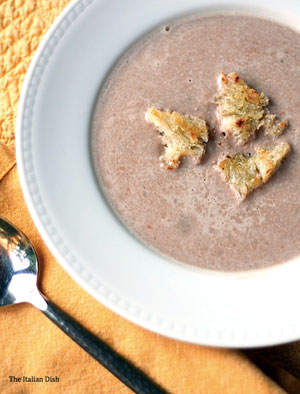 Do you ever look at chestnuts at this time of year and wonder what to do with them besides add them to stuffing? When I was a kid we used to simply roast them over the fire and they were fun to eat.
Do you ever look at chestnuts at this time of year and wonder what to do with them besides add them to stuffing? When I was a kid we used to simply roast them over the fire and they were fun to eat.
A couple of years ago, Brian and I were at a dinner party and the hostess served a first course of this soup. No one could guess what it was and it was absolutely delicious.
This soup is not a beautiful soup to look at, but I guarantee you will be amazed at how delicious it is. It would be a great first course at your Thanksgiving dinner. I topped the soup with croutons that I made using the method out of Thomas Keller's new book, Ad Hoc at Home.
These are the croutons they make at the restaurant and they are intense – garlicky, oily, and crunchy, a perfect topping for the soup. Chestnuts, nutritionally, are similar to brown rice. They are gluten free, cholesterol free, and nearly fat free.
Inspired by Pomegranates
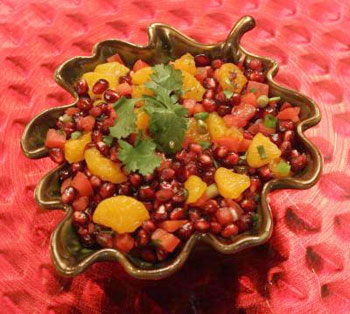 We cannot let November pass without a pomegranate!
We cannot let November pass without a pomegranate!
I love to cook and I love cookbooks, for they seem to hold sorcerer’s spells between their pages. I don’t use them when I cook, however.
I may glance over the ingredients list or temperature/time chart, but the book closes when I begin preparation. Nothing I do gets done exactly the same way twice as I cook by feel and what is in my kitchen at the time.
I say this only to encourage you to treat the following recipes casually – more as an inspiration than as a contractual obligation.
A Winter Pick-Me-Up: Roasted Vegetable Salad
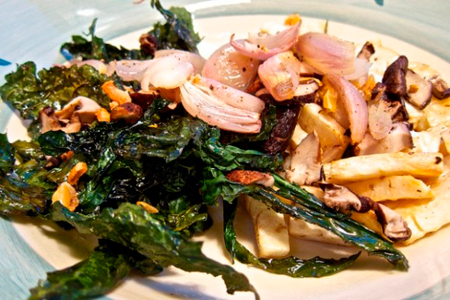 Now that the fall has given way to colder weather, enjoying winter’s chill outdoors requires a well-insulated coat and good gloves. Indoors, the kitchen fights back the cold with a hot oven and good food ready to eat. The best winter food comforts our spirits and nourishes our bodies. Nothing does that better than a roasted vegetable salad.
Now that the fall has given way to colder weather, enjoying winter’s chill outdoors requires a well-insulated coat and good gloves. Indoors, the kitchen fights back the cold with a hot oven and good food ready to eat. The best winter food comforts our spirits and nourishes our bodies. Nothing does that better than a roasted vegetable salad.
In summer, a ripe tomato salad mixed with peppery arugula leaves and bits of salty, creamy Bulgarian feta can be a meal in and of itself. When the weather cools and a weakening sun denies farmers the heat they need to grow nature’s leafy wonders, we still hunger for salads but now it’s time to look to hearty greens and root vegetables to satisfy that craving.
In winter, walking through the local supermarket’s fresh produce section, it’s easy to believe we live in a one-season world. Vegetables and fruit that require summer’s heat are stacked high in the bins. But one taste and it’s easy to tell, these delectables have been grown out of season or traveled long distances to reach our tables.
Root vegetables like celery root, beets, turnips and potatoes grow well in the colder months. When roasted, their starches convert into sugar, coaxing the best out of these subterranean gems.
Our Favorite Pomegranate Recipes
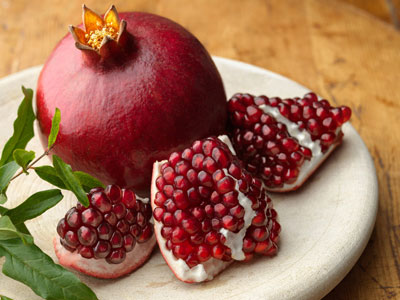 A Pink Princess
A Pink Princess
Pomegranate Martini
CosPompolitan
Pomegranate, Gouda and Pear Quesadilla with POM Salsa
Holiday Guacamole
POM and Brie Bruschetta
Chickpea Dip with Toasted Cumin and Pomegranate
Pomegranate Salsa
POM Seared Scallop Salad
Beet and Apple Salad with Honey Dressing and Pomegranate Seeds
Arugula Salad with Persimmons & Pomegranate Seeds
Pomegranate Broiled Salmon with Garlic-Smashed Potatoes
Moroccan Grilled Lambchops with Pomegranate Relish
POM-Glazed Pork Chops with Red Cabbage and Mashed Potatoes
Pan Seared Duck Breast with a POM Thyme Reduction Sauce
Pomegranate and Pistachio Ice Cream | White Chocolate Mousse with Pomegranate Sauce | POM Oatmeal Drops
POM Velvet Cupcakes with POM Cream Cheese Frosting | POM Spicy Baked Pears
More Articles ...
Welcome to the new One for the Table ...
Our Home Page will be different each time you arrive.
We're sure you'll find something to pique your interest...


